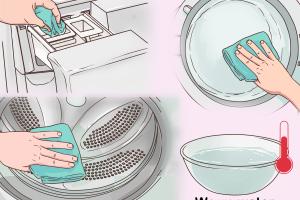Ultimate Guide to Cleaning Your Washer with Bleach: Step-by-Step Instructions

-
Quick Links:
- 1. Introduction
- 2. Why Clean Your Washer?
- 3. What You Need
- 4. Preparing to Clean
- 5. The Cleaning Process
- 6. After Cleaning Tips
- 7. Common Mistakes to Avoid
- 8. Case Studies
- 9. Expert Insights
- 10. FAQs
1. Introduction
Washing machines are essential appliances in most households, but they can accumulate dirt, detergent residue, and even mold over time. Cleaning your washer with bleach not only helps maintain its efficiency but also ensures your laundry comes out smelling fresh. In this comprehensive guide, we will take you through the steps to clean your washer effectively, using bleach as a powerful cleaning agent.
2. Why Clean Your Washer?
Cleaning your washing machine is vital for several reasons:
- Odor Elimination: Mold and mildew can create unpleasant smells.
- Efficiency: A clean washer operates more efficiently, saving you energy and water.
- Longevity: Regular cleaning can extend the life of your appliance.
- Hygiene: A clean washer ensures better hygiene for your clothes.
3. What You Need
Before you start cleaning your washer with bleach, gather the following materials:
- Household bleach
- Measuring cup
- Spray bottle (optional)
- Microfiber cloth or sponge
- Warm water
- Rubber gloves
- Old toothbrush (for scrubbing hard-to-reach areas)
4. Preparing to Clean
Follow these preparatory steps to ensure a safe and effective cleaning process:
- Read the Manual: Check the manufacturer’s instructions regarding bleach usage.
- Safety First: Wear rubber gloves to protect your skin from bleach.
- Ventilation: Open windows or turn on exhaust fans to ventilate the area.
5. The Cleaning Process
Follow these step-by-step instructions to clean your washer with bleach:
- Empty the Washer: Ensure the washer is empty before starting.
- Mix Bleach Solution: In a measuring cup, mix 1 cup of bleach with 1 gallon of warm water.
- Run a Hot Cycle: Set your washer to the hottest cycle and add the bleach solution to the detergent dispenser.
- Pause the Cycle: After a few minutes, pause the cycle to let the solution sit for about 30 minutes.
- Wipe Down: While waiting, use the microfiber cloth to wipe the door seal, detergent drawer, and exterior.
- Resume and Finish: Resume the cycle to complete the cleaning process.
- Rinse Cycle: Run an additional hot rinse cycle to clear any bleach residue.
6. After Cleaning Tips
Once you’ve cleaned your washer, follow these tips to maintain its cleanliness:
- Leave the door open after each use to allow for air circulation.
- Wipe the interior and door seal regularly to prevent moisture buildup.
- Run a cleaning cycle with vinegar monthly as a preventative measure.
7. Common Mistakes to Avoid
When cleaning your washer, avoid these common pitfalls:
- Using too much bleach, which can damage components.
- Neglecting to ventilate the area, leading to inhalation of fumes.
- Ignoring manufacturer recommendations regarding cleaning agents.
8. Case Studies
Let's explore some real-world examples of individuals who have successfully cleaned their washers with bleach:
Case Study 1: Family of Five
A family of five reported a significant improvement in their washing machine's odor after cleaning it with bleach. They followed our step-by-step guide and noted that their clothes smelled fresher after washing.
Case Study 2: Small Apartment Owner
A small apartment owner found that their washer was not draining properly due to soap buildup. After a thorough cleaning with bleach, the washer functioned like new, highlighting the importance of regular maintenance.
9. Expert Insights
We reached out to appliance maintenance experts for their insights on washer cleaning:
Expert Tip: "Regular cleaning is essential for maintaining washing machine hygiene, and bleach is an excellent option for killing bacteria," says John Doe, an appliance technician with over 15 years of experience.
10. FAQs
1. How often should I clean my washer with bleach?
It is recommended to clean your washer with bleach every 3-6 months.
2. Can I use vinegar instead of bleach?
Yes, vinegar is a great alternative for cleaning, but it does not disinfect like bleach.
3. Is it safe to mix bleach with detergent?
No, mixing bleach with certain detergents can create harmful fumes. Always use bleach alone.
4. What if my washer has a strong odor even after cleaning?
If the odor persists, consider checking for mold in hidden areas or consult a technician.
5. Can I use bleach on front-loading washers?
Yes, you can use bleach on front-loading washers, but ensure to follow the manufacturer's instructions.
6. What should I do if I spilled bleach on my clothes?
Bleach stains are permanent. It’s best to treat it immediately with cold water, but the stain may not come out.
7. How can I tell if my washer needs cleaning?
Signs include foul odors, visible mold, or detergent buildup.
8. Is there a natural alternative to bleach?
Baking soda and vinegar can help clean and deodorize your washer naturally.
9. Can I use scented bleach?
Scented bleach can be used, but it may not provide the same disinfectant properties as regular bleach.
10. Should I clean my washer before or after laundry?
It’s best to clean your washer when it’s empty and not in use. Cleaning after laundry can help maintain hygiene.
Random Reads